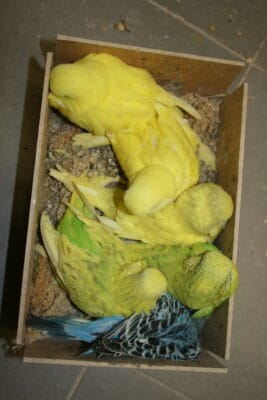
Weaning Baby Budgerigars Chicks Away From Their Parents
Successfully weaning budgerigar chicks is an essential part of breeding healthy and happy birds. Weaning chicks refers to the process of transitioning the chicks from a diet of crop milk to solid food, which is crucial for their growth and development. Here are some tips to ensure a smooth and successful weaning process.
Start the Weaning Process Gradually
 Weaning should be a gradual process that starts when the chicks are around 3 to 4 weeks old. Begin by introducing small amounts of solid food, such as millet spray or soft food, alongside the crop milk. Slowly increase the amount of solid food and decrease the amount of crop milk until the chicks are solely eating solid food. The best way to do this is to introduce millet sprays into the nest box. The chicks will initially see the mother eating this, and then will attempt to eat some themselves. When they realise what the food looks like, they tend to making weaning easier when it comes time for them to leave the nest.
Weaning should be a gradual process that starts when the chicks are around 3 to 4 weeks old. Begin by introducing small amounts of solid food, such as millet spray or soft food, alongside the crop milk. Slowly increase the amount of solid food and decrease the amount of crop milk until the chicks are solely eating solid food. The best way to do this is to introduce millet sprays into the nest box. The chicks will initially see the mother eating this, and then will attempt to eat some themselves. When they realise what the food looks like, they tend to making weaning easier when it comes time for them to leave the nest.
Offer A Variety of Foods
When the weaning chicks leave the nest and hit the floor, introduce easy to chew, soft foods. Budgerigars are naturally curious and enjoy exploring new foods. Offer a variety of fresh fruits, vegetables, and fresh seeds to ensure a balanced diet. Gradually introduce new foods to the chicks, and observe their reactions to ensure they are enjoying and accepting the new foods. Note that with chicks, they will often be very messy, so large, easy to access, flat style trays are best.
Provide Clean, Fresh Water
It is essential to provide clean and fresh water at all times. Use a water dispenser that is easy for the chicks to access, and change the water daily. Water is crucial for digestion and hydration, and it is essential for healthy growth. Always place the water at a level the birds can access – they will not normally be able to leave the nest and immediately perch, so have the access to the water at floor (tray) level.
Encourage Independent Feeding
Encourage the chicks to eat independently by placing food dishes within easy reach. Budgerigar chicks are naturally curious and will explore new things. By placing the food dish in a visible and accessible location, the chicks will start to eat on their own.
Monitor the Chicks’ Weight
When weaning chicks, it doesn’t take long for a baby to fall ill if it hasn’t been fed. This is where the keen eye of the fancier is critical. Monitor the chicks’ weight to ensure they are growing and developing as they should. Weaning can be a stressful time for chicks, and they may lose weight initially. However, if the chicks continue to lose weight or do not gain weight, it may be a sign of illness or an inadequate diet. Consult a veterinarian if you notice any concerning changes in weight.
Socialize the Chicks
Socialization is crucial for the chicks’ development and can be started during the weaning process. Spend time with the chicks, talk to them, and gently handle them to get them accustomed to human interaction. This will help ensure that the chicks are comfortable around people and will make them easier to handle in the future.
Conclusion
In conclusion, weaning budgerigar chicks is a gradual process that requires patience and attention to detail. Providing a variety of foods, clean water, and encouraging independent feeding, along with monitoring the chicks’ weight and socializing them, are essential steps to ensure a successful weaning process. With the proper care, your budgerigar chicks will grow up to be healthy, happy, and well-adjusted birds.
